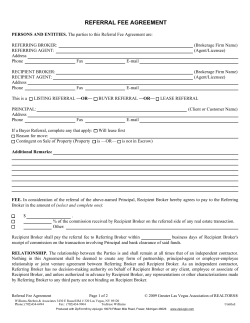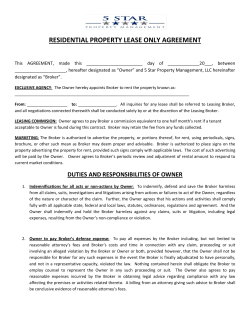
Prime Brokerage and ISDA Agreements www.cummingslaw.com
Prime Brokerage and ISDA Agreements www.cummingslaw.com Prime Brokerage and ISDA Agreements Introduction The basic services offered by a prime broker to a fund manager enable the fund manager to trade with multiple brokers whilst maintaining, in a central account with the prime broker, all of the fund’s cash and securities. These services include global custody, securities lending and financing for leverage purposes. The prime broker typically offers operational support, cash management services and portfolio reporting. Additional services can include capital introduction, consulting and risk management services. The prime broker is generally appointed by the fund, with the fund manager acting as agent of the fund, and the terms of such appointment will be set out in the prime brokerage agreement. A fund can appoint more than one prime broker and this has become more common since the financial crisis of 2008 and the collapse of Lehmans in order to spread counterparty risk. Although the prime brokerage agreement covers terms relating to such matters as custody, client money, transaction settlement, margin, securities lending, rehypothecation and fees, ISDA documentation is generally used for OTC derivatives transactions and these have to be negotiated separately from the prime brokerage agreement. (NB. Exchange traded derivatives are traded in accordance with the relevant exchange standard terms and not under the terms of an ISDA.) The following provides a brief overview of prime brokerage agreements and ISDA documentation, focussing on some of the most important terms for fund managers in each: Prime Brokerage Agreements Unlike ISDA documentation, there is no industry standard agreement governing prime brokerage and prime brokers usually have their own template, which has traditionally been www.cummingslaw.com designed to protect the prime broker from the insolvency of the fund. The financial crisis has demonstrated that the fund similarly needs to be protected from the insolvency of the prime broker, with the result that provisions relating to the following matters have become central in providing a level of protection to the fund: (i) client money and segregation of assets; (ii) custody, particularly in relation to subcustodians; (iii) rehypothecation, or use of assets; and (iv) reciprocal events of default on insolvency. When reviewing a prime brokerage agreement, it is advisable to pay particular attention to the following clauses so as to understand the level of protection the particular prime broker is offering: Client money and segregation of assets The Client Assets Sourcebook (CASS) sets out the FCA’s regulatory framework for firms which hold money on behalf of clients, where ownership remains with the client. Firms are obliged to arrange adequate protection to prevent the use of client money by the firm for its own account or misuse. However, as the Lehman collapse and its related court cases have shown, although firms are obliged to segregate client assets from their own, this did not always happen. In the Lehman litigation, the court considered the position of clients whose money was intended to be segregated, but was not. It was held by the Supreme Court that segregation takes effect on receipt of the money, rather than at the time of actual segregation; thus, a claimant’s right to share in the client money pool upon insolvency is by reference to the amount of client money which should have been segregated. The FCA has since proposed and initiated a number of changes to CASS 7 and it is very clear that the FCA attaches priority to an extremely high level of compliance in this area. Therefore, money which is held in accordance with the client money rules offers a higher level of protection compared to money to which the client money rules do not apply, such as where the client transfers the full ownership of cash to the prime broker to secure its obligations. In the latter case, the client’s claim is treated as a claim of a general unsecured creditor in the event of insolvency. to the prime broker and the prime broker’s only obligation is to return ‘equivalent assets’. If the prime broker becomes insolvent in the meantime, the fund is ranked as a general unsecured creditor in respect of those equivalent assets. One possible way to limit a fund’s exposure in this respect is to negotiate a rehypothecation limit or forbid the use of client assets. Prior to Lehman’s collapse, it was usual for prime brokers to have unlimited use, but it is becoming more common for limits to be imposed; however, this may result in higher funding costs. Custody Termination and close out rights The holding of assets other than cash is subject to the custody rules, which are set out in CASS 6. Similar to the client money rules, the custody rules require fund assets to be segregated, with the exception of those assets full ownership of which has been transferred to the prime broker (see Rehypothecation below). Of increasing importance now is to ensure that the prime brokerage agreement has adequate termination rights and close-out rights in the event of the prime broker’s insolvency. Critical terms in respect of custody are the extent to which the prime broker is able to appoint sub-custodians and to what extent the prime broker is liable in respect of such sub-custodians. It is common for a prime broker to retain responsibility for its own affiliates, but liability in respect of third party custodians can be limited. For example, the prime broker may only be subject to a duty of reasonable care in respect of the selection and on-going suitability of such sub-custodian. The use of third-party custodians may be an obvious step, as they simply hold assets and do not lend or rehypothecate such assets, but this has to be balanced against the additional cost and administrative burden. An alternative is to seek mechanisms that will permit the early release of segregated assets upon prime broker insolvency. Rehypothecation This is the right of a prime broker to re-use client assets for its own purposes. When assets are rehypothecated, title to those assets transfers www.cummingslaw.com It may be commercially difficult to secure a sufficient level of protection in a prime brokerage agreement, particularly if negotiating from a weaker bargaining position and, as mentioned above, the alternative may be to spread counterparty risk by using multiple prime brokers. AIFMD As a result of the AIFMD coming into force on 22 July 2013, please note that, where relevant, prime brokerage agreements do need to be considered in conjunction with the depositary terms set out in the Directive and its implementing level 2 measures. The extent to which the depositary terms will apply to a prime brokerage agreement will vary depending on the circumstances. ISDA Agreements ISDA has developed a standard suite of documents, all of which together form a single agreement. The single agreement attempts to avoid what is commonly referred to as ‘cherrypicking’. The standard documents include: (i) a Master Agreement; (ii) a Schedule to the Master Agreement; (iii) Forms of Confirmation; (iv) Credit Support documents; and (v) ISDA Definitions (i) Key person event i.e. death, departure or incompetency; (ii) Change in investment manager; (iii) NAV decline over 1, 3, 6 or 12 months; Master Agreement (iv) Failure to report NAV; The Master Agreement is the framework agreement, which sets out the terms under which individual derivatives transactions are carried out. There are three commonly used versions of the Master Agreement: (v) Failure to deliver financial statements; (i) The 1992 multicurrency cross-border version, designed for transactions with an international element; (ii) The 1992 local currency single jurisidiction version, designed for transactions where there is no international element; and (iii) The 2002 version, a modified version of the 1992 version, designed for all types of transactions The changes made to the 2002 version include, in particular, the following: (i) introduction of a set-off clause; (ii) market quotation and loss valuation measures replaced by a single Close-Out Amount valuation; (iii) new categories of transactions, such as repos and credit derivatives, included in the definition of Specified Transaction; (iv) grace periods for certain Events of Default reduced; and (v) Events of Default expanded to include disclaimer or repudiation. (vi) Decline in assets under management; (vii)Change in investment strategy; (viii)Breach of investment restrictions; (ix) Prohibited transaction under ERISA. It is also common for the fund manager to be obliged to make additional representations and warranties in the Schedule, in addition to those provided by the fund, and to provide indemnities to the ISDA counterparty. As a counterparty is free to make such changes to the ISDA Master Agreement as it chooses in the Schedule, it is crucial that the Schedule is reviewed carefully and new additional terms negotiated. Breach of any termination event gives the counterparty the right to terminate, so a fund manager should ensure that it is not agreeing to a clause in the Schedule which it is unlikely to be able to perform. Confirmation The confirmation, often in letter format, specifies the economic and commercial terms of each individual transaction entered into under the Master Agreement. The confirmation includes: (i) the key dates relevant to the transaction; (ii) payment obligations; The Master Agreement is never amended – this is done via the Schedule to the Master Agreement. (iii) payment mechanisms; Schedule (v) if a short form confirmation, the incorporation of the relevant ISDA definitions; and The Schedule allows the parties to tailor the terms of the Master Agreement to suit their own particular requirements and circumstances. It is common for ISDA counterparties to insert additional termination events for fund managers, such as any one or more of the following: www.cummingslaw.com (iv) administrative details; (vi) if a long form confirmation, the specific economic and commercial terms and conditions. Credit Support Annex ISDA Definitions A credit support annex (CSA) regulates collateral under the ISDA, by defining the terms and conditions under which collateral is posted to mitigate counterparty credit risk. CSAs can be either unilateral i.e. only the weaker counterparty is required to post collateral, or bilateral i.e. either party may be required to post collateral. ISDA Definitions are standard definition booklets for particular products, such as interest rate and currency derivatives, commodity derivatives, credit derivatives and equity derivatives. The relevant definitions are incorporated by reference in the ISDA Confirmation and this avoids the need to set out the full definitions in the Confirmation itself. Prior to the financial crisis, it was common for prime brokers to issue unilateral CSAs, particularly to start up funds, as it was not envisaged that the prime broker could pose a credit risk. However, in light of Lehmans, it is reasonable to expect a CSA to be bilateral. Next Steps A CSA is not mandatory, but is usually required for fund counterparties. The CSA can be customised, similar to the Schedule, and again, it is vital that the additional terms are reviewed and negotiated if necessary. This is because types of permitted collateral, thresholds, minimum transfer amounts and margin can vary between counterparties. In June 2013, ISDA published a new Standard Credit Support Annex, in an effort to promote global collateralisation standards. According to ISDA, the new SCSA eliminates the many permutations that parties may elect under the current CSA, permitting collateral eligibility, currency eligibility, threshold amounts, interest on posted collateral and initial margin requirements, for example, to be fixed and standardised. www.cummingslaw.com There are a number of issues to consider when reviewing prime brokerage and trading documentation, whether you are entering into a new relationship with a prime broker or custodian or wishing to revisit existing agreements on the basis of a stronger negotiating position. Cummings Law advises on and negotiates prime brokerage agreements, ISDAs and other trading and brokerage documentation. If you would like to discuss this further, please contact Claire Cummings at Claire.Cummings@ cummingslaw.com or on 020 7585 1406. This document is for general guidance only. It does not constitute advice January 2014 42 Brook Street, London W1K 5DB +44 20 7585 1406 | Neuhofstrasse 3d, CH-6340 Baar +41 41 544 5549 Regulated by the Solicitors Regulation Authority
© Copyright 2025


















